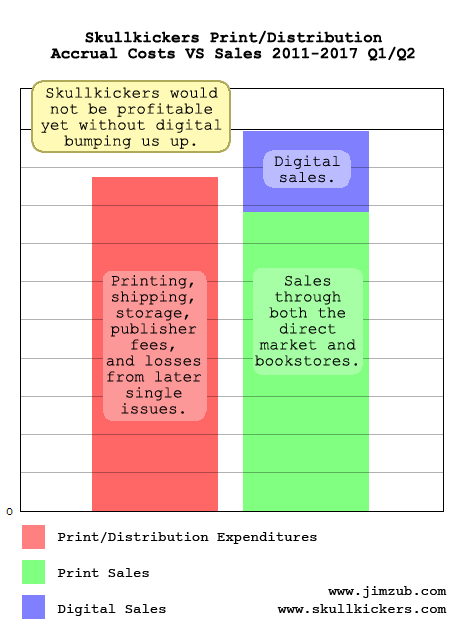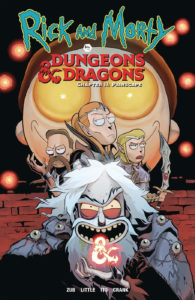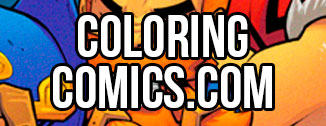It’s been more than two and a half years since I wrote anything about Skullkickers sales numbers. I didn’t avoid talking about it on purpose, I just felt that with the series wrapped up and Wayward still underway it should be the focal point for my financial analysis. Poring over the numbers takes time and so Wayward was the natural choice for that attention. Last week’s article about trade sales seemed to cover everything I needed to say about the current market.
Boy, was I wrong. I received my Skullkickers accrual statement late last week and the data in there kind of blew my mind. I had to put together a new financial article here to go over it.
Some back story for those of you catching up: Skullkickers was my action-comedy sword & sorcery comic released by Image Comics from 2010 to 2015. Co-created with Chris Stevens and illustrated by Edwin Huang and Misty Coats with lettering by Marshall Dillon, it was my “break-out” book, but mostly on a critical level. Fantasy can be a tough sell. Humor even more so. Put those two elements together with creators who weren’t known (at the time) and it was a challenge to make our mark. We had a wonderful and loyal core readership and good word of mouth, but never lit sales charts on fire.
Skullkickers wasn’t really profitable during its run, but it did get my name out to a much wider audience and opened the door for some of my early work-for-hire comic writing projects: 19 issues of Pathfinder at Dynamite, a Shadowman fill-in issue for Valiant, and a 2-part Legends of the Dark Knight story for DC. It was a way to show people what our team was capable of and build a body of consistent work.
When sales flagged, I ran contests, put together a ridiculous reboot parody promotion, and even started serializing the comic online for FREE to expand our readership. Each of those PR stunts helped us inch along and, in the end, we eked out 34 issues (six story arcs) and finished the story the way I intended. Skullkickers is now handsomely collected in 6 trade paperbacks or 3 deluxe hardcovers.
Every six months, I’d receive an accrual statement from Image that outlined how deep the financial hole was. They could see we were slowly digging ourselves out with digital and collection sales, but the numbers didn’t seem to be in our favor. When the series wrapped up mid-2015, I’d resigned myself to the fact that Skullkickers as a whole would probably never do better than break-even, even if it did propel me forward in terms of my writing career.
Cut to 2017. Check this out:
(Update: Image’s Accountant dropped me a line to let me know I that the way digital was shown on the latest accrual was being misinterpreted so I’ve made corrections. We are selling solidly on digital, but it’s a more reasonable percentage of our overall sales, not the gonzo spike in sales I thought it was. I’ve corrected the text and chart to reflect that change.)
Image has been smart about including Skullkickers in a lot of their digital sales, as well as putting the first 18 issues (3 story arcs) on comiXology Unlimited, a flat fee all-you-can-read service on the leading digital comics platform. Tens of thousands of new readers have discovered the series through Unlimited, and that led to more digital collection sales. The whole series is still available for FREE on our webcomic site, and yet we keep selling Skullkickers on digital platforms, month after month.
What does this mean? Well, here’s the accumulated debt versus sales chart, the one I feared would never balance out:
Thanks to slow but steady collection and digital sales, we are truly ‘in the black’. As of mid-2017, I can no longer say that Skullkickers is my lovable-yet-financially-forlorn creator-owned comic. It has finally climbed out of the pit and is holding the bloody detached head of its captor while letting out a triumphant roar.
Don’t get me wrong, I’m not going to be smoking hundred dollar bills or paying off my house with these profits. It’s quite slim right now, but it’s also open-ended; We still have print collections in stock (and our only expenditures on those right now are storage since they’re already printed and shipped to Diamond Distribution) and the digital platform never closes or runs out of copies. In six months we should make a bit more, and then a bit more, and then a bit more, hopefully ever onward into the future until every single person who reads the work I do over at Marvel realizes that the action-packed mirth they enjoy in Thunderbolts and Avengers was there right from the beginning with Skullkickers.
Image Comics (especially Publisher Eric Stephenson) deserves a ridiculous amount of credit for letting me make Skullkickers my own way, start to finish. 25 years ago, the company started with a desire to put creators first and they still do that every single day. I feel incredibly fortunate to have launched the series there and can’t think of another publisher that would have taken this on and let the long tail run its course this way.
Is Skullkickers a success? It really depends on how you measure it. This will sound dorkishly earnest, but for me it’s always been a success. We built a story I’m incredibly proud of, my love letter to Conan, D&D, and the fantasy genre as a whole, and got it out to a wider audience. It was a life-changing milestone in my creative development that led to a dozen other comic projects and where I am today. The dollars and cents are a crucial metric, of course, but not the sole reason for heading into a creative project.
Some words of warning: Please don’t use these charts as some kind of battle plan for your own comic-making dreams. Creative careers vary wildly and I’ve spoken to dozens of creators who have thrown inordinate amounts of good money after bad paying for art, coloring, lettering, printing, convention tables, and stomach pills for financial ulcers brought on by creator-owned comics. I was able to dig deep with Skullkickers because I had (and still have) a stable day job and solid freelance work paying the bills. I never put myself in a position where my day-to-day financial commitments were in doubt and if the series had never made a dime I still would have been okay.
The sales history of Skullkickers is very different from Wayward and Glitterbomb, my other two Image creator-owned series. Each series has its own unique sales history and, while this stuff is really interesting to analyze, it isn’t any kind of formula you could reproduce (and, with a 7-year bloody trek to financial sanity for SK, you probably wouldn’t want to anyway).
If you found this post interesting, feel free to let me know here (or on Twitter), share the post with your friends and consider buying some of my comics, donating to my Patreon, or buying comics from me in person if you see me at a convention.









 Zub on Amazon
Zub on Amazon Zub on Instagram
Zub on Instagram Zub on Twitter
Zub on Twitter
Zubz, you’re a badass! Thank you for sharing all your info, it puts so many unknowns into a slightly less unknown perspective.
Cheers,
Logan